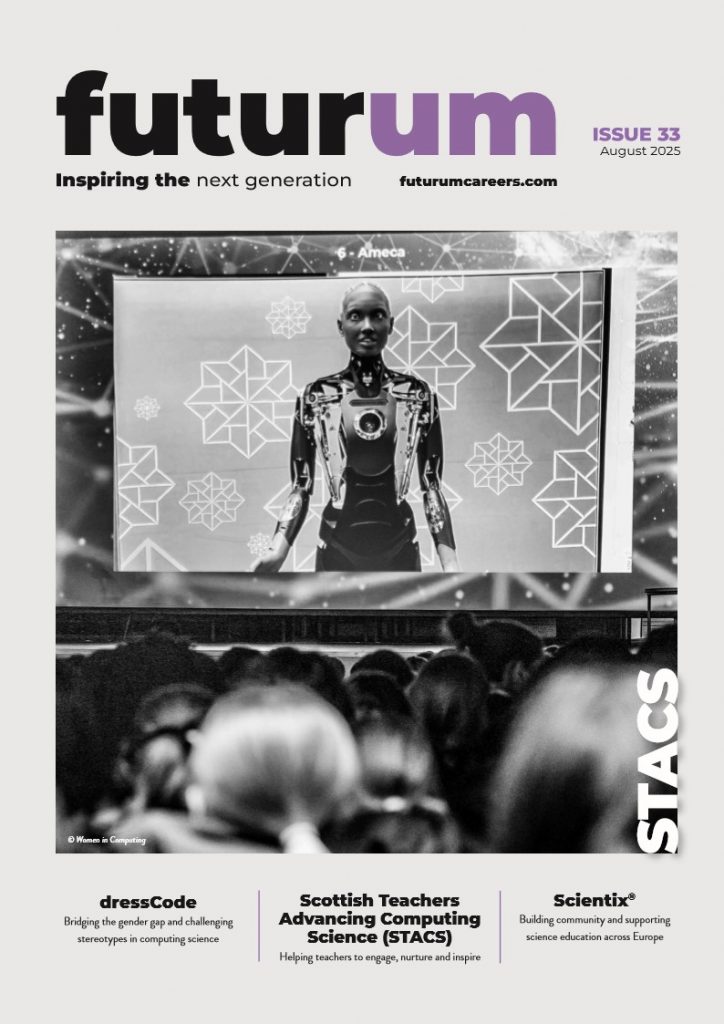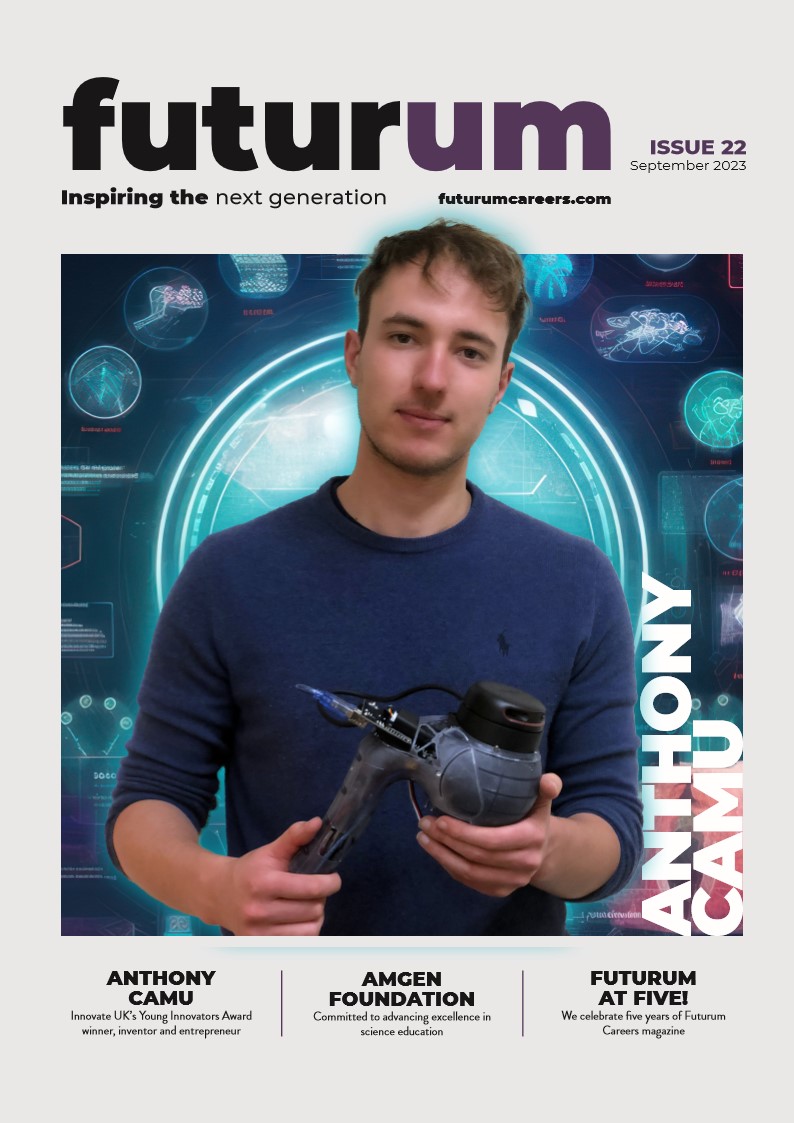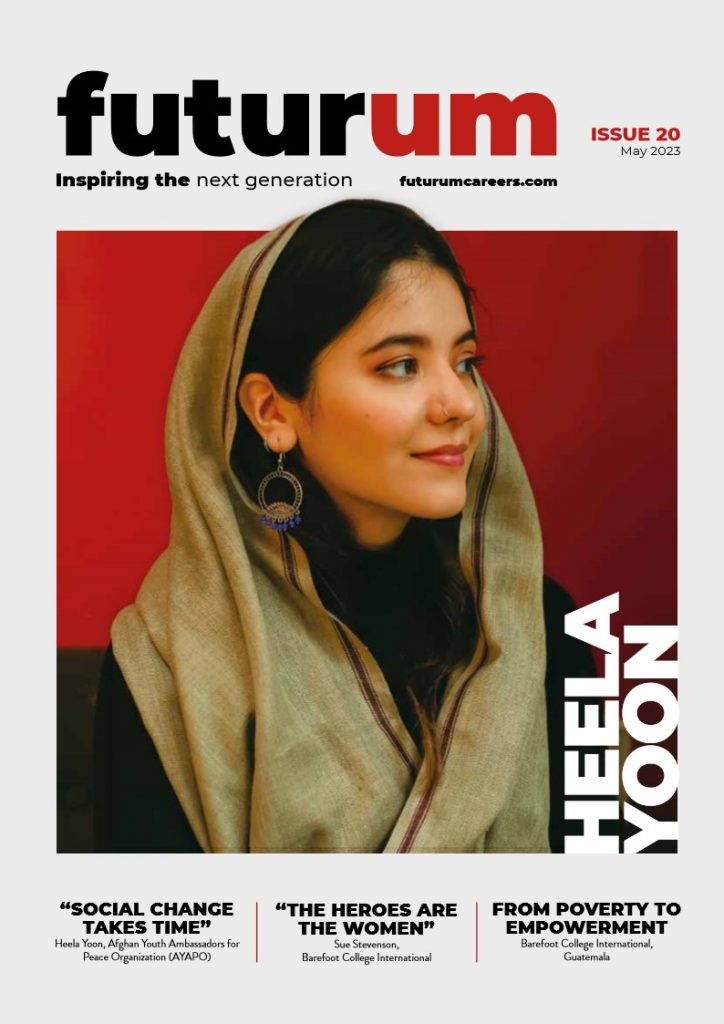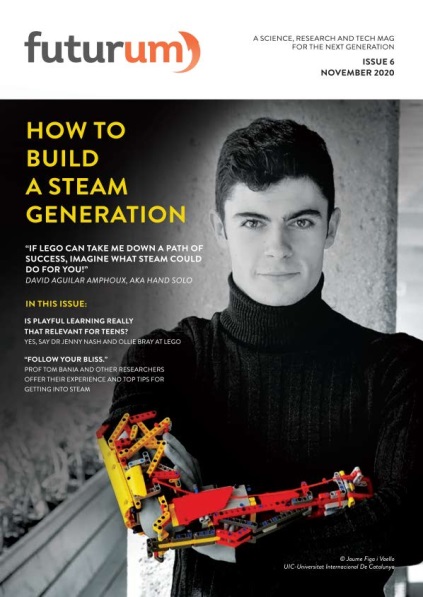Issues
Issue 35
Career journeys
When we know what opportunities are available to us, and when we are empowered to make choices, we can take control of our own career journey.
Many students enjoy STEM, but they do not always know where it can take them, and personalised careers guidance can be difficult to access in busy, time-pressured schools. To support teachers in enabling young people to take the lead in exploring career journeys for themselves, STEM Learning UK has set up Destination STEM. National Lead Ajay Sharman introduces this innovative online platform.
Highlighting the wide range of opportunities that come with a background in STEM, Let’s Talk Science is committed to preparing young people in Canada for future careers in a rapidly changing world. Founder and President Dr Bonnie Schmidt tells us about the charity’s 30-plus years of innovative STEM programmes.
There are exciting journeys ahead… whatever your destination.
Issue 34
‘Learning how to learn together’
Founded in 2010 by Dr Dan Roronhiakewen (He Clears the Sky) Longboat and Dr Chris Furgal, TRACKS (TRent Aboriginal Cultural Knowledge and Science) Youth Program in Canada teaches Indigenous and non-Indigenous young people the benefits of braiding Indigenous Knowledge and Western science. We learn how the TRACKS ethos of ‘learning how to learn together’ provides young people with a fuller picture of the environment and a deeper understanding of our place in it. And it’s not only students who are learning to learn together.
Science on Stage Europe is a vibrant network, supporting educators in their professional development and spreading inspiring teaching concepts across Europe. Chair Stefanie Schlunk tells us about the organisation’s unique ‘from teachers for teachers’ approach and how investing in teachers is investing in the future.
For adults and youngsters alike, some of the most powerful learning we experience is shared with others. Let’s keep learning and growing together…
Issue 33
Science shapes us all
“I love that technology is integral to every sector and is so creative. You can turn ideas into reality, solve real-world problems and make a difference,” says Toni Scullion, a Co-lead of Scottish Teachers Advancing Computing Science (STACS) and founder of dressCode.
Sharing Toni’s belief that science impacts and provides opportunities for us all, Dr Agueda Gras-Velazquez, Science Programme Manager at Scientix® and Head of the Science Education Department at European Schoolnet®, enthuses, “Science shapes every aspect of our daily lives, from the food we eat to the technology we use. It opens up a world of infinite possibilities for everyone.”
We love talking to passionate people who are doing their bit to inspire young people. From computing science to oncology, cell biology to archaeology, there is much to be inspired by…
Issue 32
Fellowship and coalition
10 years ago, two organisations, separated by the Atlantic Ocean but joined by their missions and values, were forming. Both organisations appreciated the opportunities STEM can offer youngsters and valued community spirit, fellowship and coalition.
Today, STEM Fellowship, based in Canada, and the EU STEM Coalition, spanning Europe, look back with pride at the impact they have had – and look forward with an ever-strong commitment to empowering youngsters and the people who work with them.
For both organisations, and for all the educators and students they impact, it’s exciting to see what the next 10 years will bring. As Beatrice Boots, Director of the Dutch national STEM platform (PTvT) and Chair of the EU STEM Coalition, says, “…now we have to grow our movement and get better results together!”
EQUS
A celebration of excellence in quantum research
“EQUS is the Australian Research Council Centre of Excellence for Engineered Quantum Systems. Our mission is to engineer the quantum future by building quantum machines that harness the quantum world for practical and ground-breaking applications.
This magazine highlights examples of the fascinating research conducted at EQUS and shares some of the personal journeys of our researchers. I know their stories will resonate with you and demystify the realm of quantum physics. Enjoy reading about their work and be inspired: the quantum revolution is an exciting time for every one of us, and one which you can help drive forward!”
Professor Andrew White
Centre Director, Australian Research Council Centre of Excellence for Engineered Quantum Systems
Issue 31
Finding your passion
“Our vision has always been to inspire young people, no matter their background, to learn more about STEM subjects and to gain insights into exciting potential career paths,” explains Helen Cuthill, CEO of The Smallpeice Trust. Through educational resources, events and scholarships, The Smallpeice Trust fosters young people’s passion for science and engineering.
With expert insights into graduate pathways and experiences, the University of London Careers Service knows the importance of finding where your passions lie – and exploring where these passions could take you – and provides invaluable advice for young people starting out on their career journey. As Oby Oputa, Associate Director of Small Specialist Colleges, enthuses, “there are thousands of jobs out there that you might not know about, and it’s never too early to get researching.”
As you read this issue of Futurum, be inspired, reflect on your own interests and find your passion…
Issue 30
Empowerment
Personal achievement requires aspiration – an understanding of what can be aimed for and a confidence that we are able to reach that goal. Once we feel empowered to aspire, our potential is endless.
In its mission to promote social mobility and diversity in STEM, In2scienceUK focuses on empowering young people by helping them to see what they are capable of. Head of Programmes Anishta Shegobin tells us about the charity’s In2STEM programme.
With the same understanding of how important it is to recognise our capabilities, getTWOit is working to accredit skills developed through SHAPE subjects. Head of Partnerships Kristina Tischendorf introduces getTWOit’s microcredentials.
Throughout this issue of Futurum – as ever –, you’ll find inspiring people who demonstrate that achievement comes when we do not limit ourselves. Empowering ourselves with knowledge of what can be achieved feeds our self-confidence – and self-confidence feeds ambition and success.
Issue 29
The power of networks
Forming networks and collaborating with communities drives progress and innovation.
Bibliothèques Sans Frontières facilitates access to information and educational resources, working in more than 26 countries, in 37 languages, and reaching over 2 million beneficiaries in conflict zones, refugee camps and under-resourced communities.
Aspect is a network of 36 universities, with growing international interest, supporting over 600 SHAPE (social sciences, humanities and the arts for people and economy/environment) research academics to develop innovative ideas and build commercial skills.
And biomedical scientist Bamidele Farinre highlights the importance of mentorships and collaborating with a network of peers.
Networks are powerful things, linking people and communities, building skills and resilience, and forging endless possibilities…
Shaping the future
In this special issue of Futurum we are celebrating all things SHAPE!
Professor Julia Black, co-founder of the SHAPE initiative, explains the importance of social sciences, humanities and the arts for people and the economy. Having taken part in the SHAPE in Schools pilot project, drama teacher Anne Dunkerley highlights the power of the arts. And, as leader of ASPIRES, Professor Louise Archer examines the influences on students’ education and career aspirations.
How can art help children cope with eco-anxiety? How can economics help police combat crime? How can music technology help people with dementia? How can ghost stories connect people to history? These are just some of the topics we explore to inspire students to SHAPE the future!
Issue 28
Building capital
Arts Emergency CEO and co-founder Neil Griffiths tells us how the UK-based charity is helping young people to expand their cultural capital. Professor Louise Archer, who has led the ASPIRES project, is investigating the importance of young people’s science capital. And Amie Kirby, a member of Arts Emergency’s Youth Collective, highlights the importance of seeking help from others.
Build your capital, aspire and find support. This issue of Futurum is a good place to get started…
Issue 27
Reshaping role models
Callie Winch tells us about the Stemettes’ white paper, which is urging the government, educators, and parents and carers to help more young women and non-binary individuals to see that they belong in STEM.
Dr Jennifer Jakobi and Dr Catherine Mavriplis from the Natural Sciences and Engineering Research Council of Canada’s Chairs for Women in Science and Engineering highlight the innovative and impactful network they are part of.
Issue 26
Supportive communities
With the same aim of supporting others to aspire and achieve, Rachel Ryan is a proud member of the Stemette Futures Youth Board (p 52) in the UK. Having grown in confidence through a role where she is helping others, Rachel describes the Stemettes Society as “a supportive, inspirational environment”.
Issue 25
Thinking big
National Star student Sam Vestey (p 4) is putting his vision for the future into action, leading a campaign to launch a more inclusive disability badge – one that moves away from the assumption that all disabilities are visible. He explains, “My end goal is to head off to the United Nations and get this new logo recognised as the international disability badge.”
Issue 24
Confounding expectations
In a country where literacy rates are far lower for girls than for boys, empowering women to become entrepreneurs is no mean feat. The founder of Thinking Minds Ghana, Seth Panyin Boamah (p 04), tells us about the initiative that is challenging societal expectations to achieve just that.
Based at Brunel University in the UK, bioscience lecturer Dr Chinedu Agwu introduces BioSci Toolkit (p 42), an information resource page set up to support more students – especially those from BAME communities – to think beyond the traditional STEM choices of medicine and engineering and pursue bioscience.
Issue 23
It’s never too late!
Duncan O’Leary (p 46) shares the belief that a real difference can always be made. Duncan is CEO of the UK’s New Futures Network, a specialist employment team in His Majesty’s Prison and Probation Service (HMPPS). Connecting employers with prison leavers, New Futures Network is evidence that it is, indeed, never too late to enable change – giving someone a second chance can reap huge rewards for you, them and society as a whole.
Issue 22
A celebration!
In September 2018, co-founders Brett Langenberg and Karen Lindsay published the first issue of Futurum magazine. Five years on, and with 22 issues in the Futurum library, we look back and celebrate the milestones that have contributed to Futurum Careers’ ongoing success (p 64).
Inspired by observing a visually impaired person guided through a busy train station, Anthony Camu designed Theia, a handheld orientation and mobility device for blind and partially sighted people (p 04).
The Amgen Foundation (p 34) is committed to advancing excellence in science education. President Scott Heimlich explains, “We need to support more people to understand and appreciate the role of science and biotech in our lives.”
Issue 21
Podcasts for impact
“A lot of the work I do is mission-driven… When I think about what I’m going to make, I don’t think about how much money it’s going to create, I think about what kind of impact I want to have,” says Gael Aitor who, along with Kayla Suarez, tells us about their hugely successful Teenager Therapy podcast and ambitions for their new podcast network, Astro Studios (p 04).
Founders of the Help! Make it Make Sense podcast (p 34), immunologist Dr Aimee Pugh Bernard and physician Dr Toni Eyssallenne highlight the impact of empowering others. Aimee explains, “We strive to … explain the information in ways that are easy to understand so that people can feel empowered to make decisions based on this information.”
With a passion for informing and impacting others, the Astro Studios and Help! Make it Make Sense teams are using podcasts as the tool for connecting more directly with their audiences, for speaking to – and with – others. And so is Futurum!
Issue 20
Sharing voices
For every issue of Futurum magazine, we have the huge privilege of working with a diverse range of researchers, representing a wide variety of fields, from around the world. We learn about their backgrounds, ambitions, hard work and commitment, and the incredible successes they achieve. We also learn about the importance of diversity and representation – how the world is all the better for different voices driving the conversation of progress forward.
One such force for change is Heela Yoon (p. 4), founder and CEO of the Afghan Youth Ambassadors for Peace Organization (AYAPO). She explains, “Social change takes time, especially when tackling big issues like violent extremism and gender inequality in countries like Afghanistan.”
All the contributors in this issue have progress in their sights – for their work, wider society and the next generation who will take the mantel forward. And we will be with them – applauding people’s efforts, celebrating their successes, and amplifying a diversity of voices to ensure we all remember why the work is needed.
Issue 19
“I get to break into computer systems and manipulate people to get information – almost like a super-spy!”
Sharing Mia’s passion for cybersecurity are Orange Cyberdefense’s Catherine Boddy and Zoe Grist (p. 76), both of whom love their roles in an industry that is evolving constantly. Data Science Lead at Nesta, Dr Rachel Wilcock (p. 44) tells us about the job she revels in and how data science can be used for innovative social good.
These brilliant women – and the great range of researchers featured in issue 19 of Futurum – highlight the joy and satisfaction people get from careers that contribute to a healthy, happy and productive society. They also demonstrate that there are opportunities for progression everywhere, even without a set plan. Put your preconceived ideas aside for a moment and explore…
Issue 18 – Part 1
Welcome to the new look Futurum magazine – part 1!
For this special issue, we knew we needed someone as ambitious and forward-thinking as we are for our cover star. Step forward Tshepiso Malema (p. 04), a student from South Africa who has turned his love of computer games into unique and life-changing enterprises, providing students with guidance and mentorship on their careers, and instilling a spirit of entrepreneurship.
Issue 18 – Part 2
Welcome to the new look Futurum magazine – part 2!
Futurum magazine is more accessible and visually appealing than it has ever been, and we could not be prouder of issue 18 – parts 1 and 2 – and of the inspiring articles it contains. We are excited to see what the future holds – both for us and the next generation!
Issue 17
“WE HAVE TO PULL THE INNER INNOVATOR OUT OF EVERYONE”
As the researchers in this issue demonstrate, there are many questions needing creative, analytical thinkers in STEM and SHAPE to solve them, from understanding the structures that exist in the Earth’s mantle (p 80) to investigating how the human body reacts to physical trauma (p 20). By sharing these research projects, and the stories of the researchers behind them, with students, we – and you – can inspire the inner innovator in everyone.
Issue 16
REDRESSING THE BALANCE
In striving for more diversity in STEM, however, we must not forsake SHAPE. Social sciences, humanities and the arts are as significant as science, technology, engineering and maths. The interdisciplinary nature of today’s world means we need more diversity and inclusion in all fields. With passionate advocates such as Aleisha and the many researchers featured in this issue, we know the balance is being redressed. And we need to keep going…
Issue 15
CHANGEMAKERS AND LEADERS
An international, non-governmental organisation dedicated to supporting social entrepreneurship, Ashoka envisions a world where everyone is a changemaker and identifies and supports social entrepreneurs who are leading the way in this regard. But what does the term actually mean?
According to Ashoka, a changemaker is someone who “imagines a new reality, takes action and collaborates with others to bring that new reality into being for the good of others”. It has partnered with the Edge Foundation to pilot a changemaking and leadership programme for schools in Greater Manchester, UK. Only a few months in, headteachers and their students are already experiencing a positive impact.
Jaiden Corfield is leading the youth side of the Ashoka programme. He shows us that there is no defined or ‘right’ path to success and that everyone can become a changemaker and leader, just like the researchers in this issue. The projects our featured academics are working on require imagination, action and collaboration to make new realities happen.
Issue 14
HOW TO TEACH THE FUTURE
“Without climate education, I don’t see the value in going to school at all,” says Eleanor Andrade May, a quantitative social science student at the University of Sheffield (p 4). This is a disconcerting statement. When students are unable to see the connection between their studies and their future, it suggests a deep flaw in our education system. Fundamentally, we are failing our young people.
But young people are taking action. Eleanor is part of Teach the Future, a youth-led campaign that aims to repurpose the UK’s entire education system around the climate emergency, and this action makes for a very positive statement.
Teach the Future’s vision is for broad climate education in the UK. Futurum’s vision is to help students connect the subjects they are learning in school to real-world research projects, all of which aim to solve pressing societal needs. Where there is vision, there is action, and this is how to teach the future.
Issue 13
AN ILLUSTRATION OF INCLUSION
“Don’t tell me the moon is shining; show me the glint of light on broken glass.” This beautifully evocative quote, attributed to the playwright Anton Chekov, has been used by storytellers worldwide to teach budding novelists the concept of ‘show, don’t tell’. The aim of this writing technique is to immerse the reader in the story, drawing them in to the world of the fictional character rather than simply telling them what is happening in the story.
Chidiebere Ibe’s illustration of a Black fetus (p 4), Soapbox Science (p 36) and the Africa Science Buskers Festival (p 68) are all powerful demonstrations of the significance of showing, not telling.
The researchers in this issue come from a wide variety of backgrounds and are communicating their work in a manner that shows students a pathway to rewarding and impactful careers. As Dr Nathalie Pettorelli, founder of Soapbox Science, says, “Scientists come in all shapes and sizes”. Futurum is here to show your students just that!
Issue 12
EVERY CHILD DESERVES A CHAMPION
“Every child deserves a champion, an adult who will never give up on them, who understands the power of connection and insists that they become the best they can possibly be,” said the late Rita F Pierson, a TED speaker and professional educator who spent her entire life in or around the classroom.
In this issue of Futurum, we feature education champions Keishia Thorpe (p 4) and Matina Razafimahefa (p 40). An English teacher at International High School Langley Park in the US, Keishia has been awarded the Varkey Foundation Global Teacher Prize 2021 for opening up college education for low-income, first generation American, immigrant and refugee students. 23-year-old Matina has set up SAYNA, an online learning and crowdsourcing platform that not only teaches people key IT skills but offers them employment, too.
As Dr Joi Spencer (p 44) says, “I see education as a liberating tool. […] I can train one mathematics teacher who will go on to inspire thousands of young people. That is incredible!”
Issue 11
CAREERING AHEAD
Between 2010-2018, less than two-thirds (63%) of students aged 15-16 reported having received any careers education and only half had undertaken work experience. This is one of the findings from a report published by academics working on ASPIRES 2, a mixed-methods research project that investigated young people’s science and careers aspirations in England from ages 14 to 19.
High quality careers education is essential for encouraging and maintaining a diversified and flourishing workforce. It is for this very reason that Sir John Holman was commissioned by the Gatsby Foundation to devise a framework for world-class careers guidance in England (p 50). Happily, this framework, known as the Gatsby Benchmarks, is starting to take effect.
Then there is Jack Parsons, the UK’s Chief Youth Officer, who is on a mission to help young people thrive (p 4). He founded The Youth Group, which aims to support young people and connect them with opportunities in the world of work. “With so many opportunities entering our doors every second, there is a huge amount of hope for young people,” he says.
Issue 10
GET INTO SHAPE!
Which word is a verb and a noun, is wonderfully flexible and has the power to steer you towards a rewarding career?
The answer is SHAPE, which stands for Social sciences, Humanities, and the Arts for People and the Economy. “SHAPE subjects help shape how we see the world, how we might change it, and how we express ourselves,” says Julia Black, President of the British Academy and one of the architects of the SHAPE campaign. “‘You can shape the future. You can say you’re a shaper or SHAPE person! The word itself seems to be quite inspirational and is giving momentum to our campaign.”
STEM and SHAPE are not opposing forces – they are a collaborative effort, enabling people from a range of fields to solve some of the planet’s greatest challenges together. As artist and environmentalist John Sabraw says, “It’s not just about two disciplines working side by side in a space, it’s about people creating something new from collaborations. Now we’re asking: What is design, what is art, what is data, what is science, and what is the public outreach? It’s all becoming a little blurry and I like it.”
Issue 9
YOU CAN BE WHAT YOU SEE
Positive role models are vital. As children grow older, teachers, friends, peers, people in their local communities and celebrities become increasingly influential – and the wider their circle of influence, the more likely they’ll see themselves reflected in role models who may be BIPOC, female, LGBTQ+ or people with a disability.
Shrouk El-Attar, an LGBTQ+ refugee, belly dancer and one of the UK’s top six young women engineers, says: “Growing up around other people who didn’t feel marginalised or had role models already for them, I could see the difference and how powerful that was for them.”
From a computer scientist using AI for inclusion and social good to an anthropologist advocating the need for Indigenous Knowledge in schools and universities, our researchers are passionate about sharing their work with you, so that students all over the world can be what they see.
Issue 8
STARS IN OUR EYES
Mention the word ‘star’ and some people will think of celebrities and influencers, while others will gaze up into the night sky and wonder at the glittering constellations. What would your students be thinking?
According to Morning Consult, 54% of 13-38* year-olds in the US say they would become an influencer, if they had the opportunity, and an overwhelming 86% are willing to post sponsored content for money. Given these statistics, and the huge numbers of followers that influencers have, it is highly likely that a social media star will be at the forefront of young people’s minds. We want to ensure that young people understand that being a star does not necessarily mean having the greatest number of followers. Being a star is about finding the light that shines within you – finding the subjects and a career path that will give you the most joy, and sharing that joy with others so that the world becomes a better place.
Issue 7
007: LICENCE TO SKILL
Films play a significant role in shaping our perceptions of science and scientists. Take James Bond, for example. It tops all the blockbuster films, including Harry Potter and Jurassic Park. It seems generation after generation cannot get enough of spy-fy – the secret agent, Q, the gadgets and the villainous boffins, whose madness borders on genius.
Over the years, James Bond films have adapted to their time, paying homage to the latest technologies and innovations of the era (nuclear energy, space travel, bioweapons, cybersecurity) and becoming (or attempting to become) more inclusive. And, just as film lovers are fascinated by Q’s latest technical innovations, we are in awe of the researchers who have shared their projects with us in this issue. They are at the forefront of innovation; they are dedicated to equality, diversity and inclusion; and they are on an important and vital mission: to inspire the next generation into STEM, STEAMM and research.
Our researchers are heroic agents of change, too!
Issue 6
HOW TO BUILD A STEAM GENERATION
So many of the researchers we work with mention LEGO. Whether they’re playing it with their children or reminiscing about the sets they played with when they were children, LEGO crops up a lot. Dr Jenny Nash, Head of Education Impact (p4), provides us with a snapshot of LEGO Education’s latest initiatives, designed to help build the next generation of STEAM experts. Ollie Bray, LEGO Foundation’s Tech & Play and Playful Schools Lead (p8), explains the concept of the playful pedagogy, and why playful learning is just as important for secondary and high school students as it is for primary and elementary school pupils.
David Aguilar Amphoux shares his inspirational story about love, loss and living with a disability. He built his first prosthetic arm using LEGO when he was only 9 years old and wants to use his bioengineering skills to help others with disabilities.
Like David, the researchers in this issue are using their knowledge to solve some of the world’s biggest challenges. They share their tips and expertise so that a new STEAM generation can follow in their footsteps.
Issue 5
FOOD FOR THOUGHT, RIGHT HERE…
Food: We all need it to survive; we all use it to celebrate, commiserate and commemorate. Why not let food be the focus of our school curriculum, from which all other subjects – physics, chemistry, social sciences, PSHE – feed?
Dr Christian Nansen argues that food, as an educational denominator, can address societal challenges, elevate levels of empowerment and teach our children everything they need to know about maths, engineering, life sciences – essentially all school subjects and more.
In this issue, we feature 21 research projects that give your students plenty of food for thought. Some of these projects directly relate to food and agriculture; others tackle key societal challenges such as health and wellbeing, and sustainable energy. Above all, the researchers’ passion for STEM and STEAMM education shines through in all 21 of these projects. As Prof Stephen Self says: “You should be prepared to take STEM courses because they essentially underpin many other subjects.”
Issue 4
WHAT HAPPENS WHEN GEOLOGY MEETS CHEMISTRY?
How does interdisciplinary research translate in the classroom? One way to view it is to see it in the context of cross-curricular learning. Even though school curriculums tend to require teachers to teach their subjects in silos, there are lots of benefits to cross-curricular learning: one being that students learn how to see the world holistically.
The research projects in this issue will provide your students with enough inspiration to view the world holistically; to see that some problems need a team of engineers, chemists and psychologists to solve them.
As economist Prof Sayantan Ghosal says in his article (p12), “Try not to get too bogged down in maths – the primary concern behind economics is attempting to understand the world around you.”
Issue 3
DO SOMETHING AMAZING. BECOME A CITIZEN SCIENTIST
Without citizen scientists, many research projects wouldn’t get off the ground. Citizen scientists help researchers collect and explore huge data sets, which might need the involvement of thousands of people, or data from people all over the world, or to cover huge distances. What’s key is that citizen scientists don’t need a science qualification. Anyone – and that means you – can participate. In this mag, there are lots of ideas for citizen science. For example, you could:
• Comb the beaches for microplastics
• Classify glitches in space
• Spread facts about biosecurity so diseases don’t spread
• Join a youth jury and advise the government on cyber safety
But, whatever you’re interested in, a simple internet search will have you involved in wildlife surveys, monitoring noise pollution, counting passing meteors – you name it –, a research project that is just right for you!
Issue 2
WHERE WILL STEAMM TAKE YOU?
Issue 1
SOCIAL MOBILITY AND THE SCIENCES






































